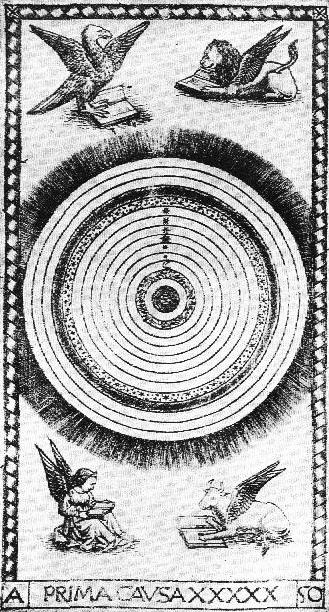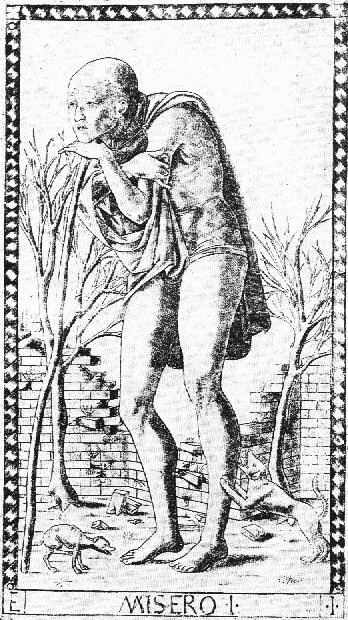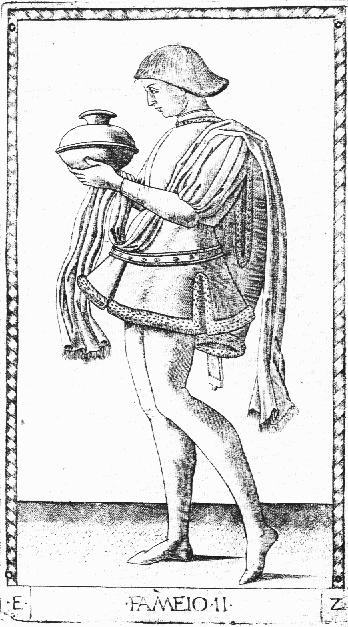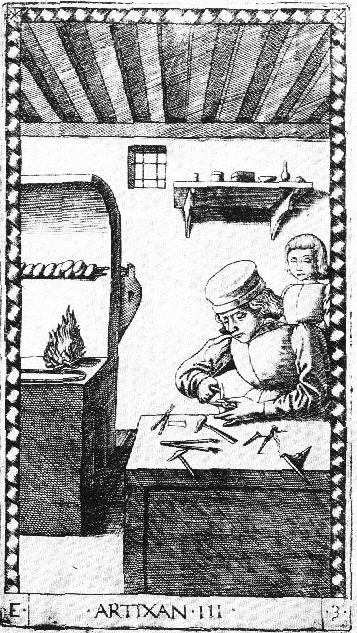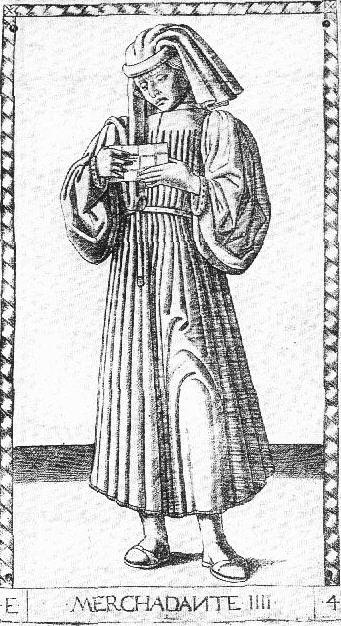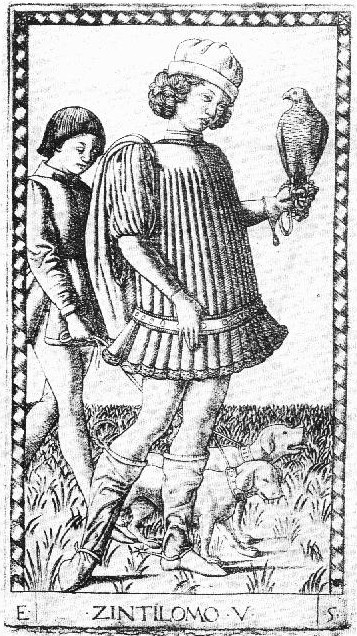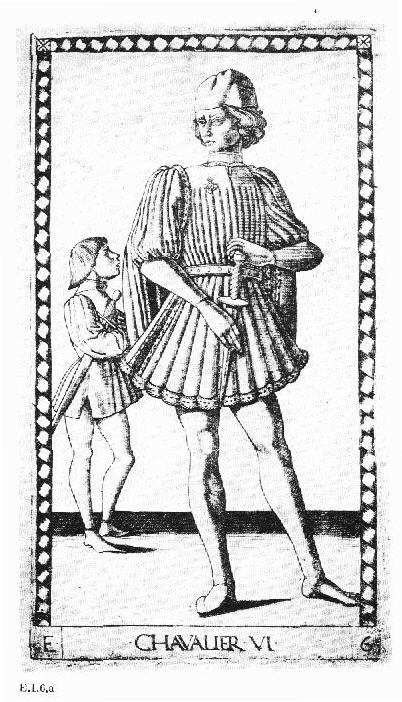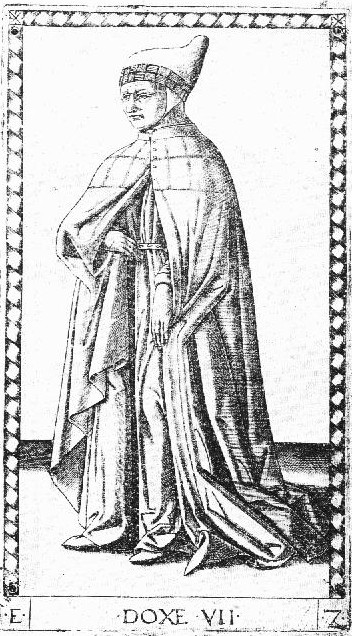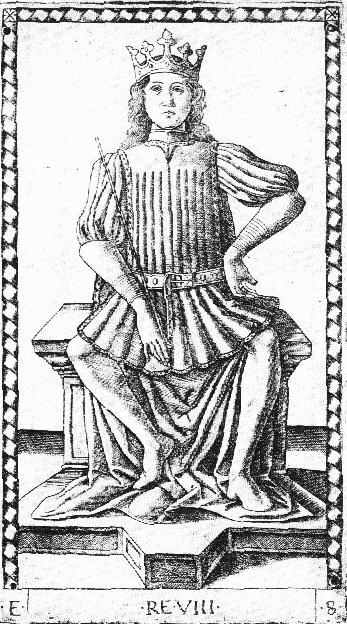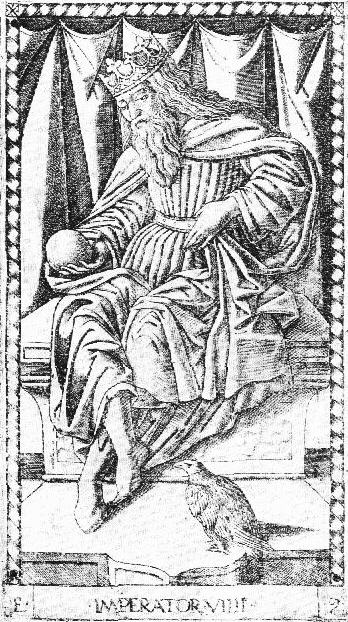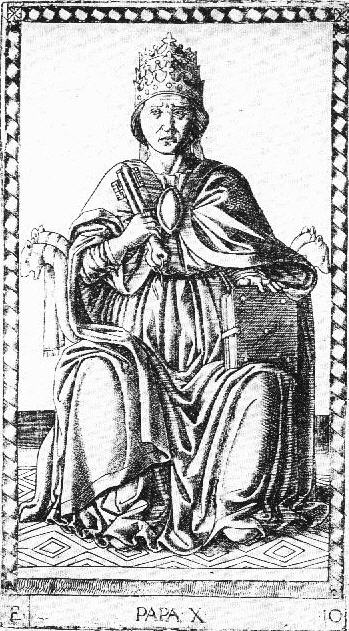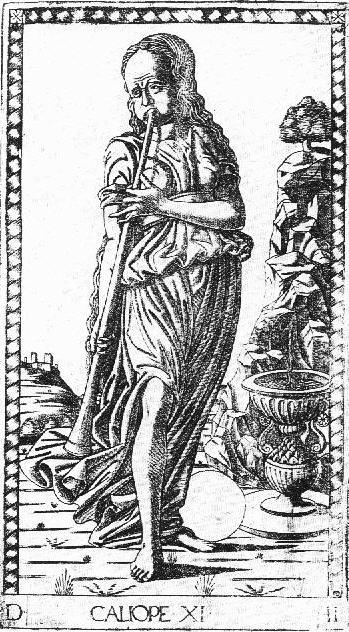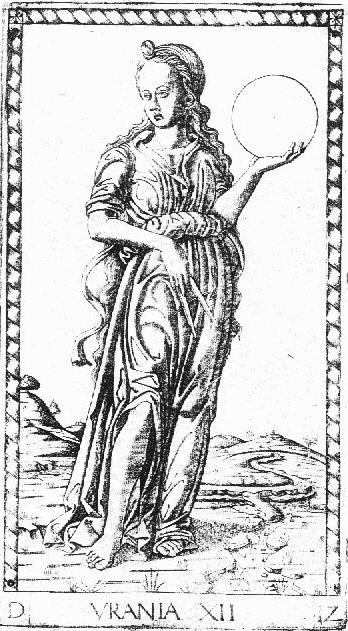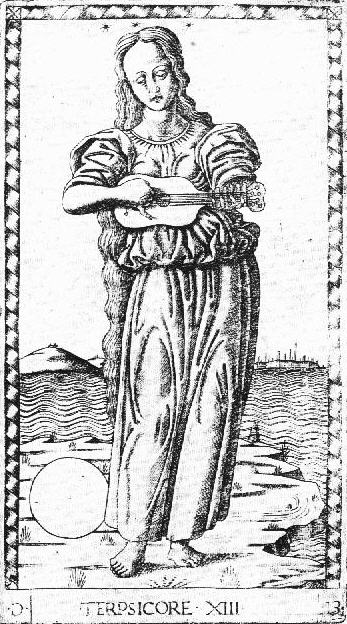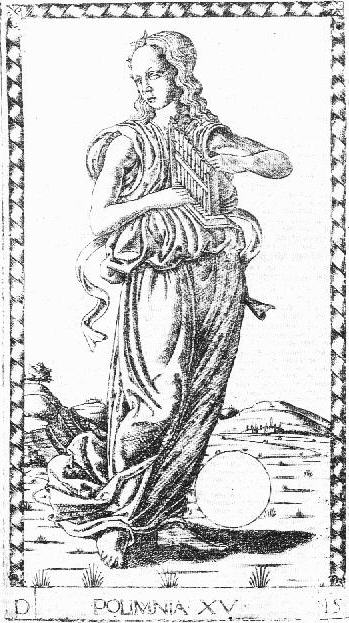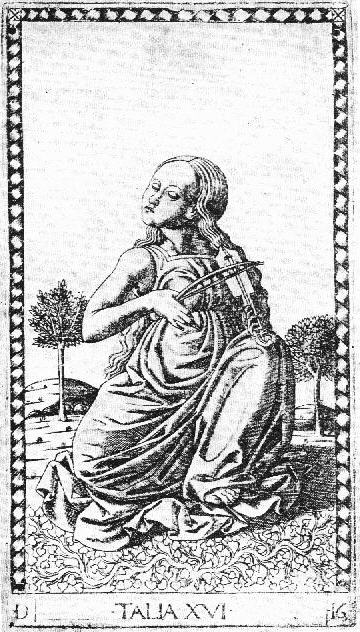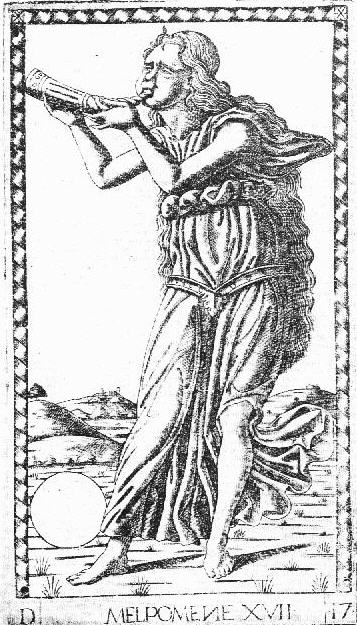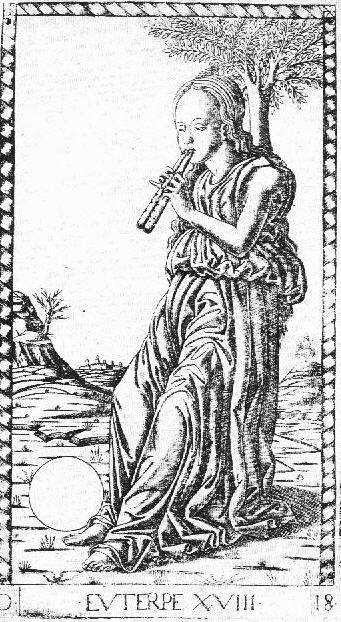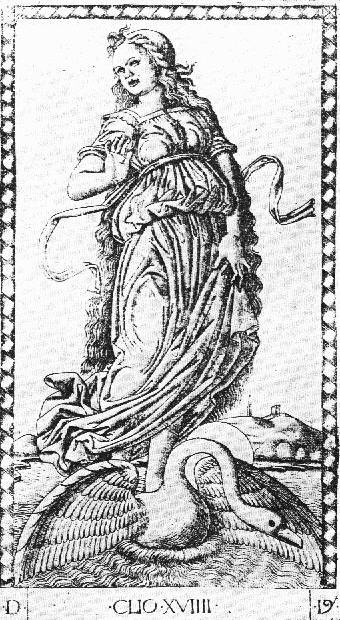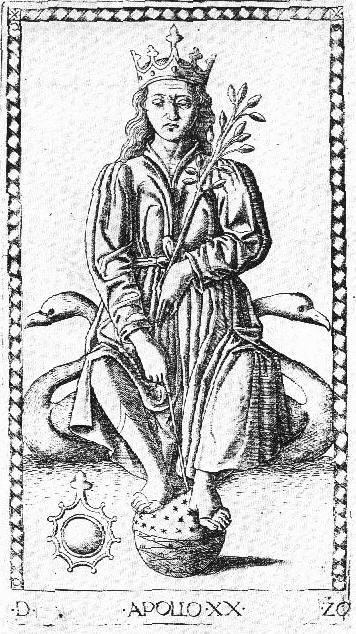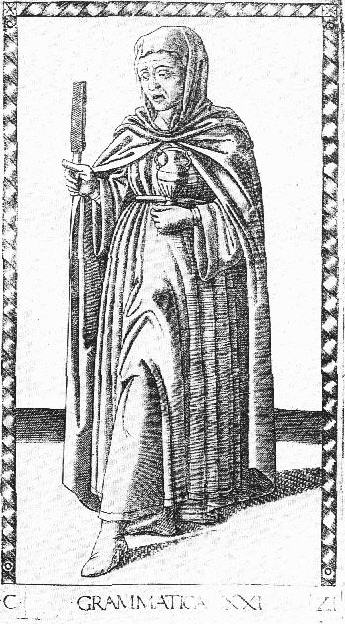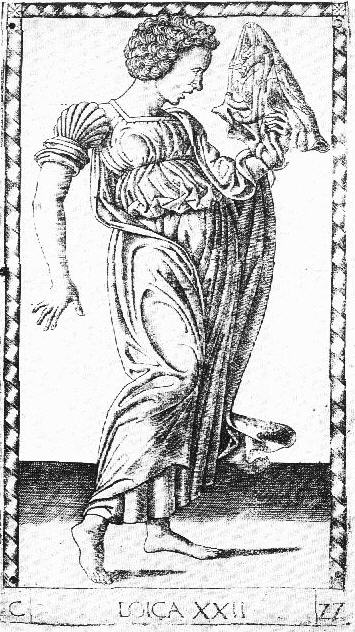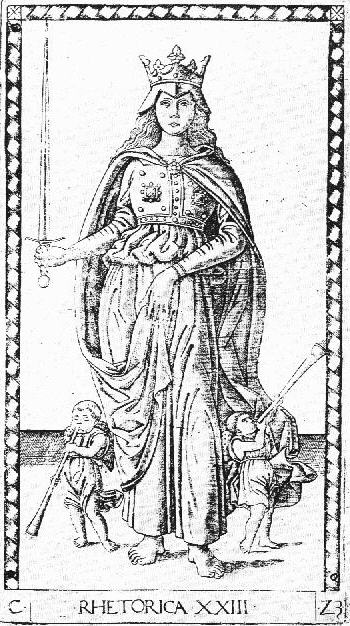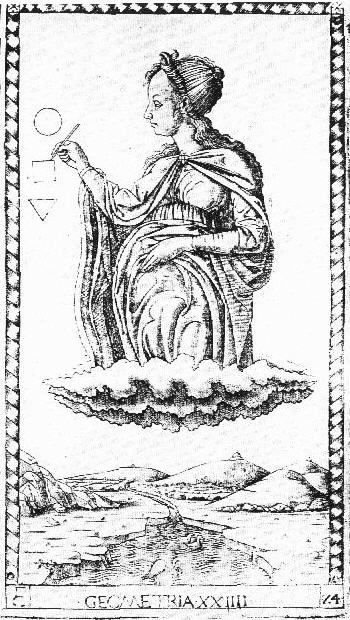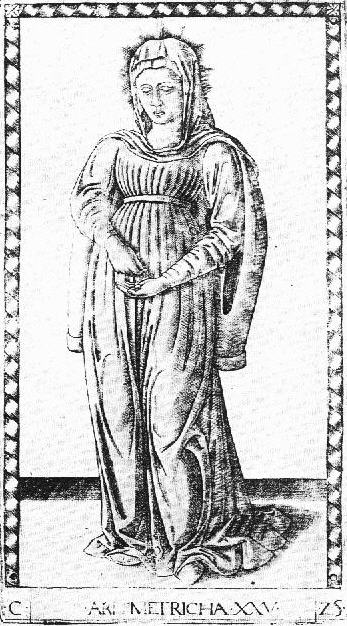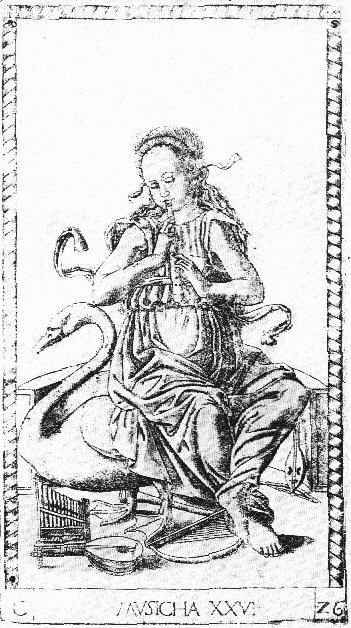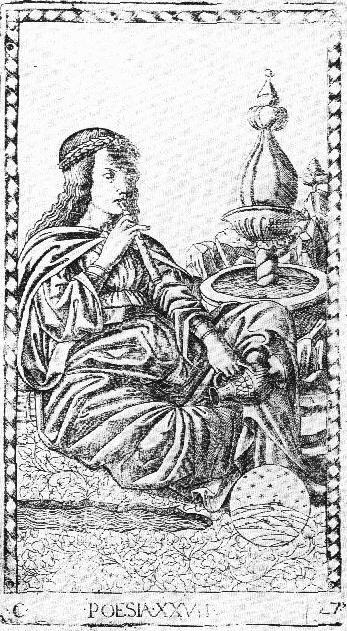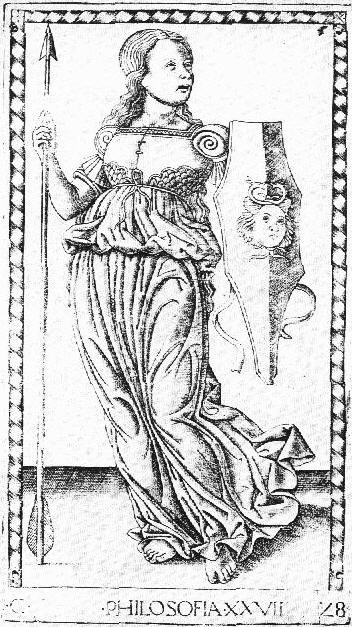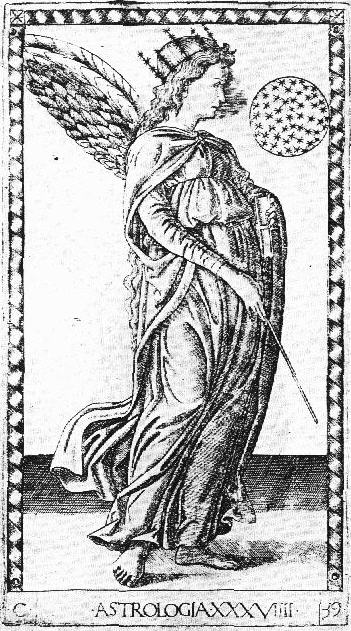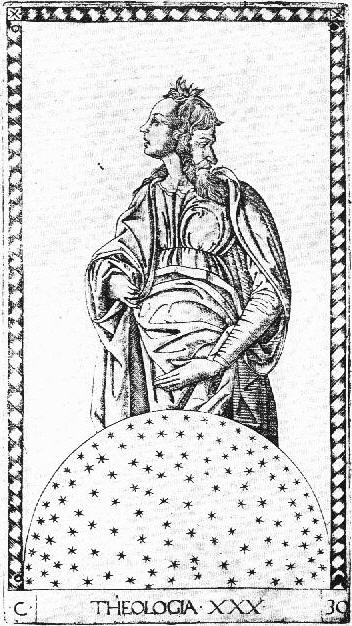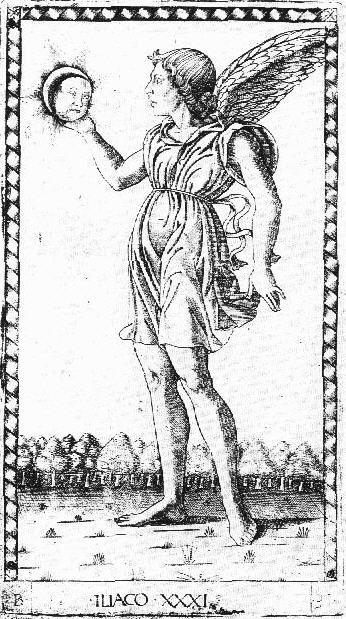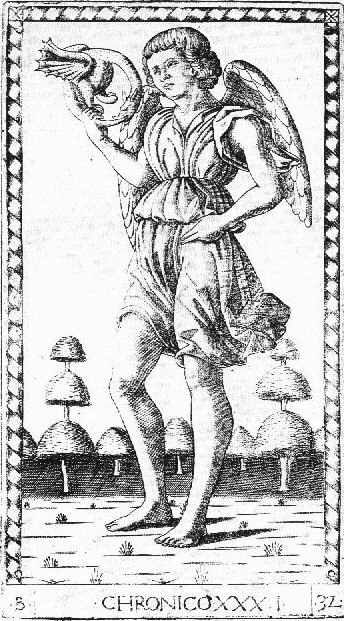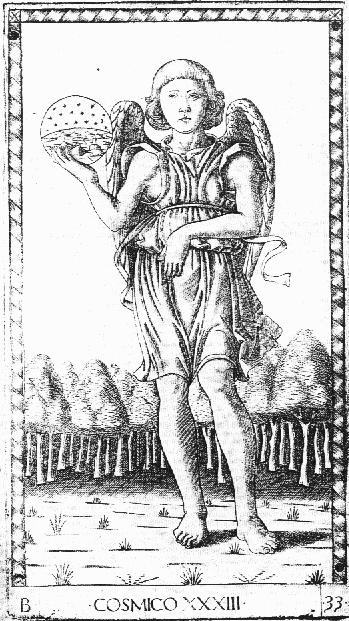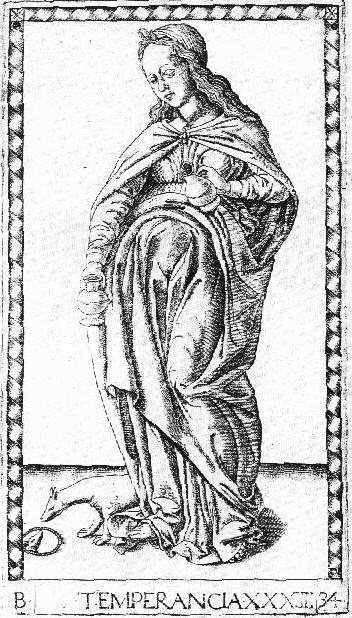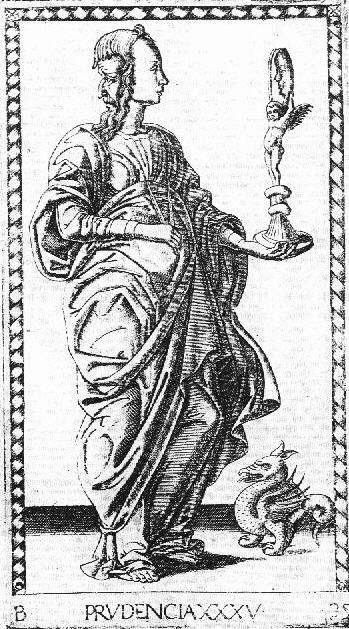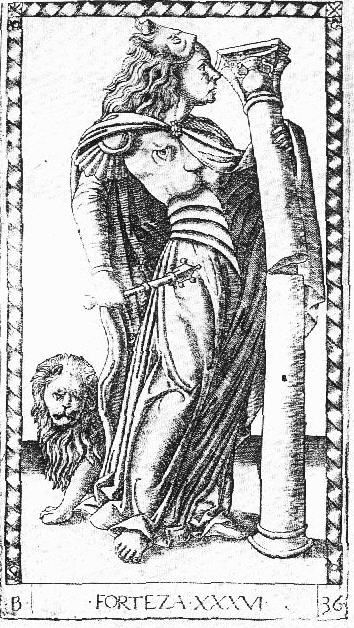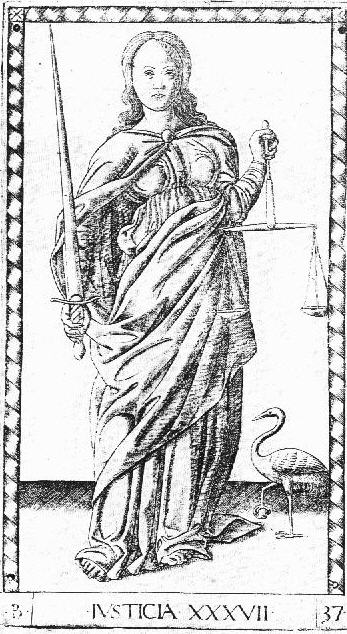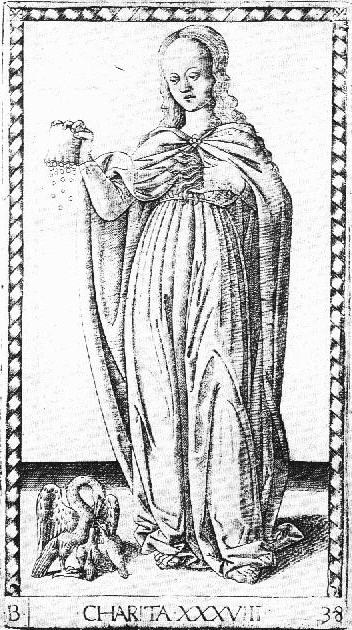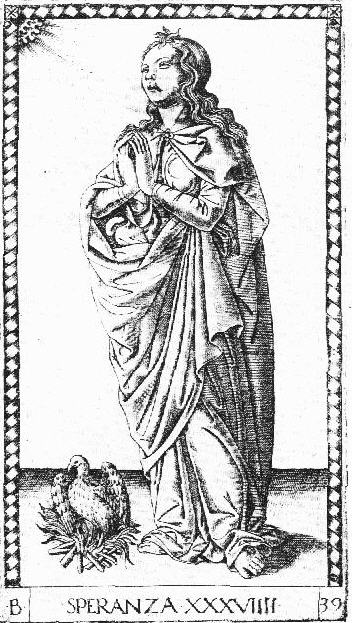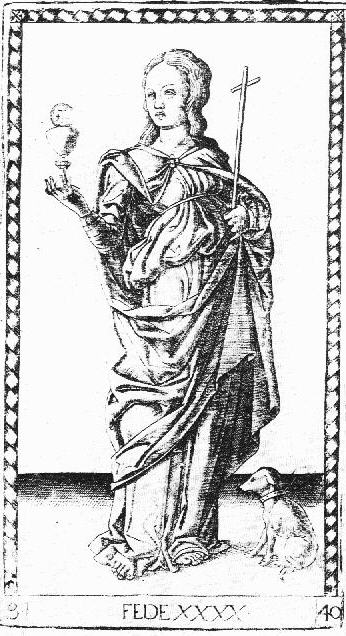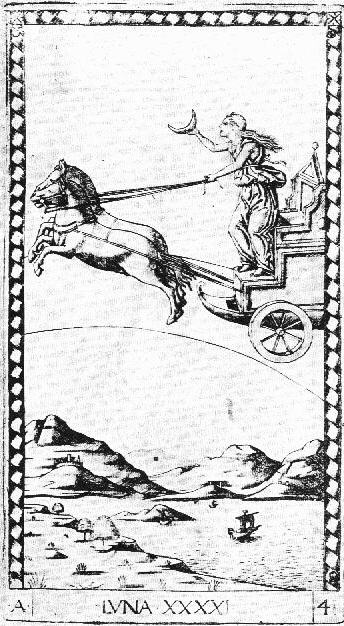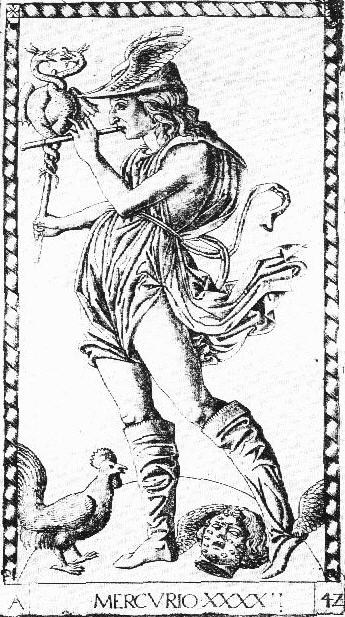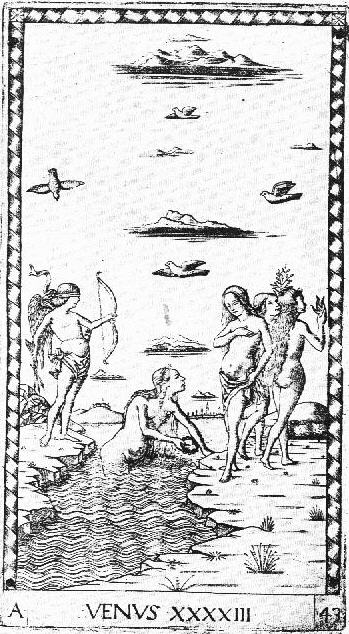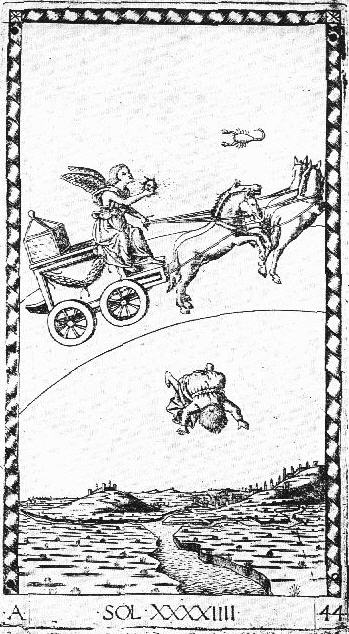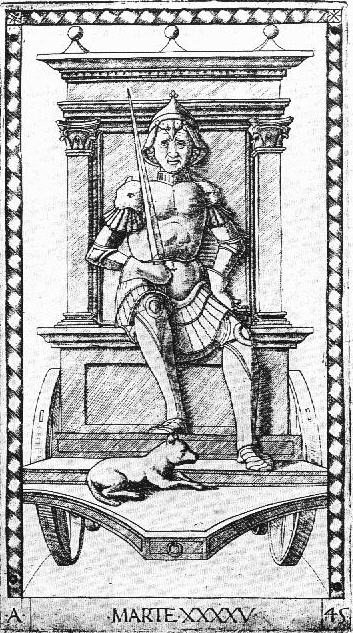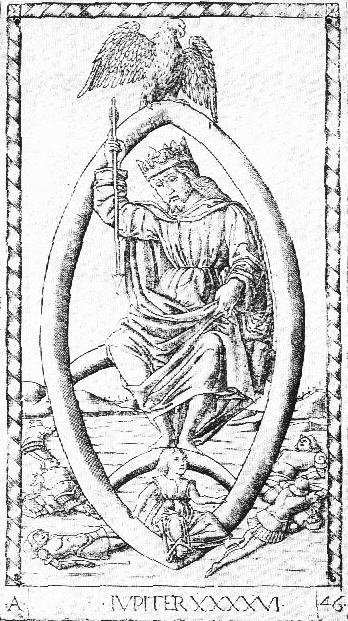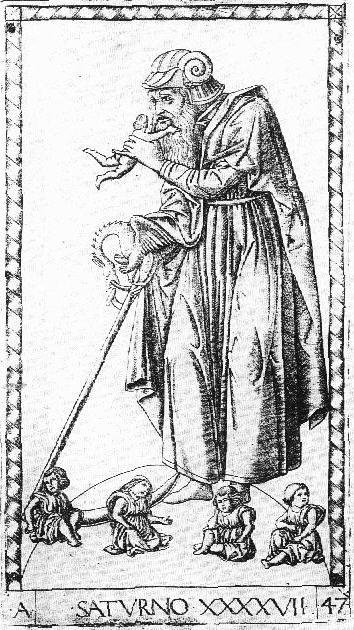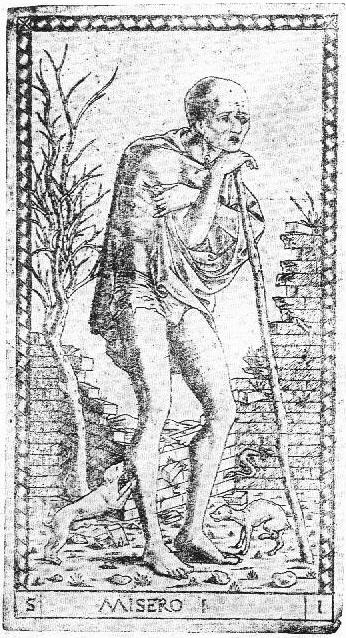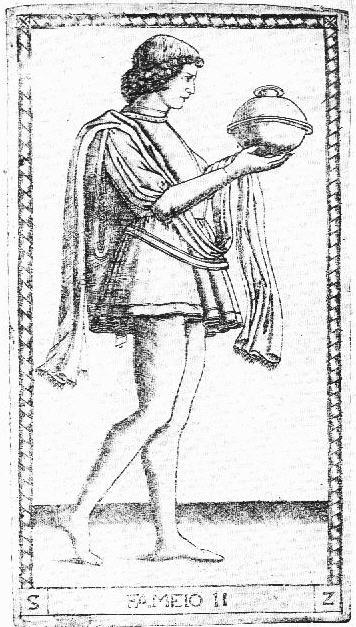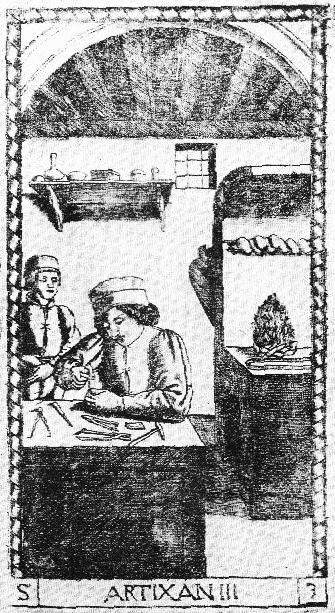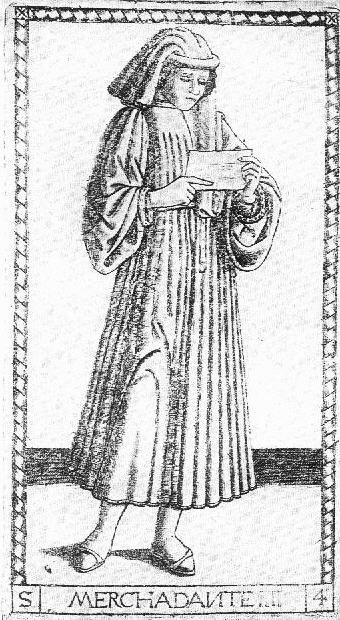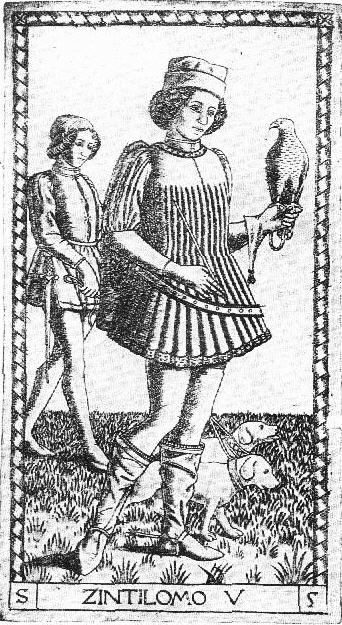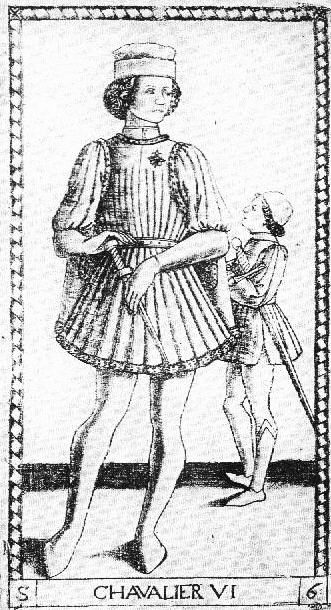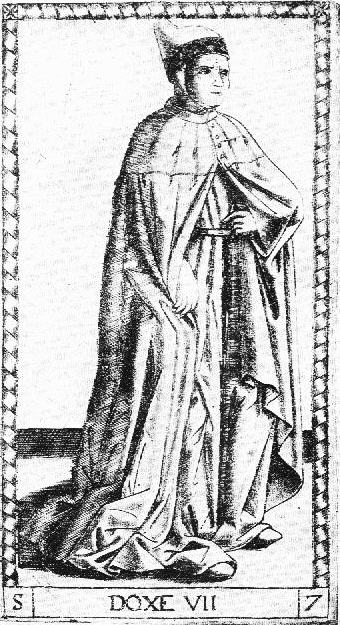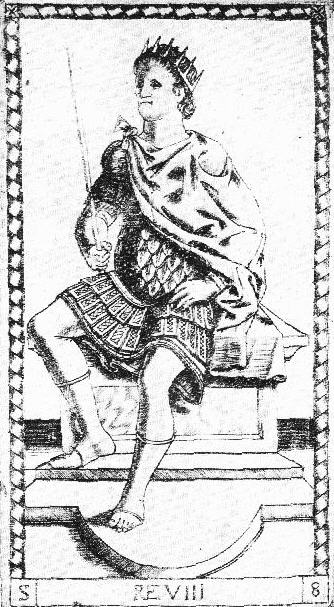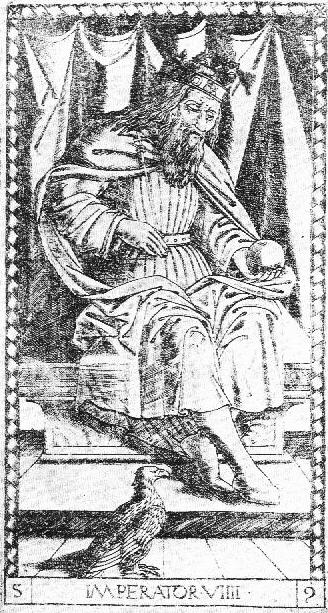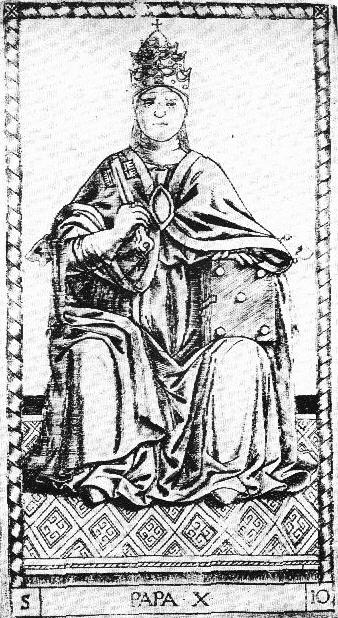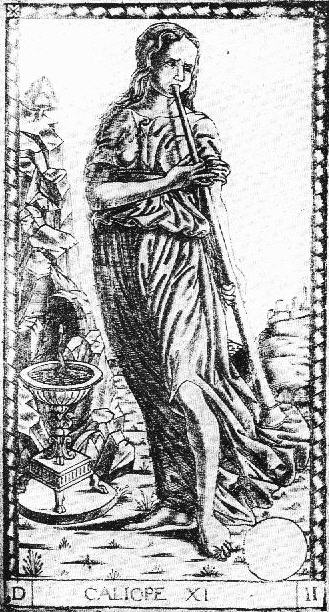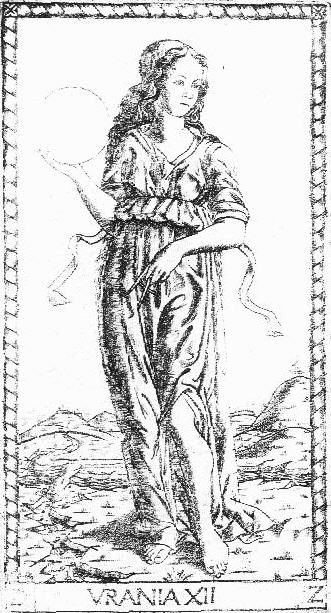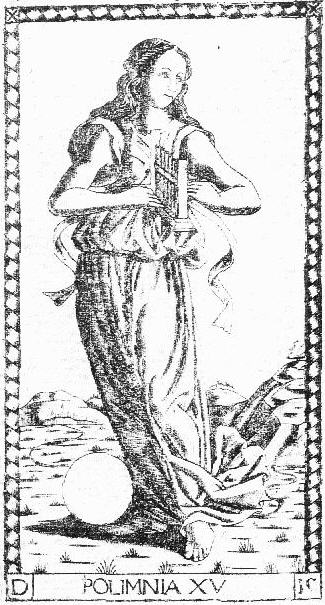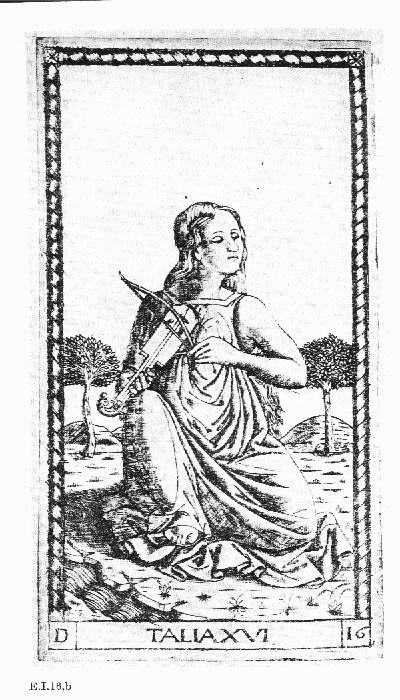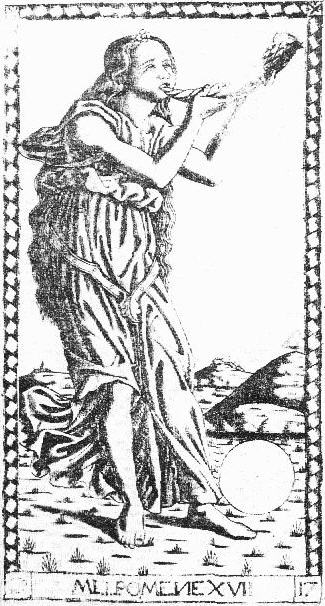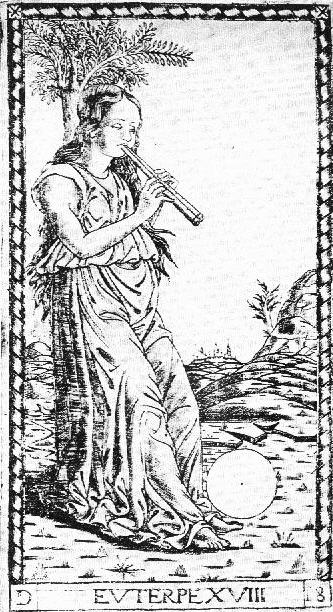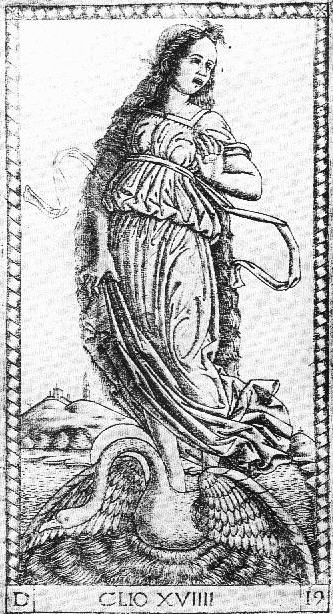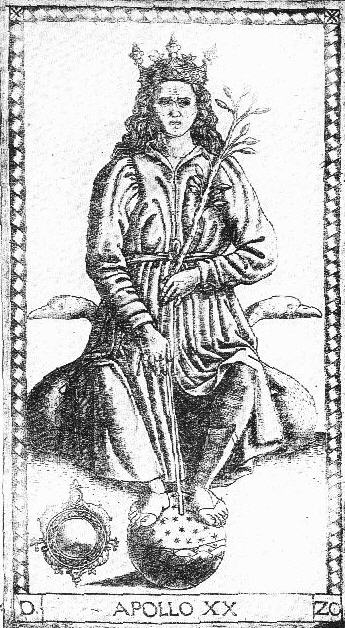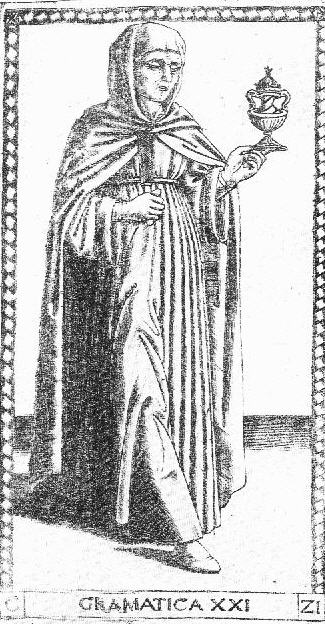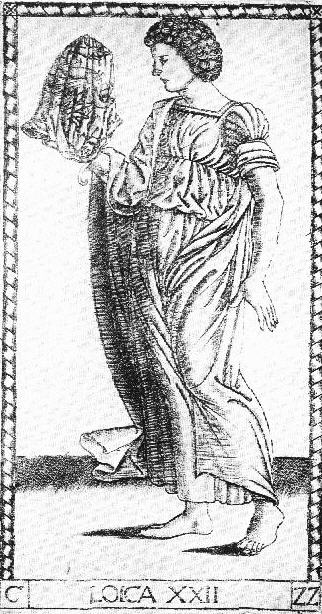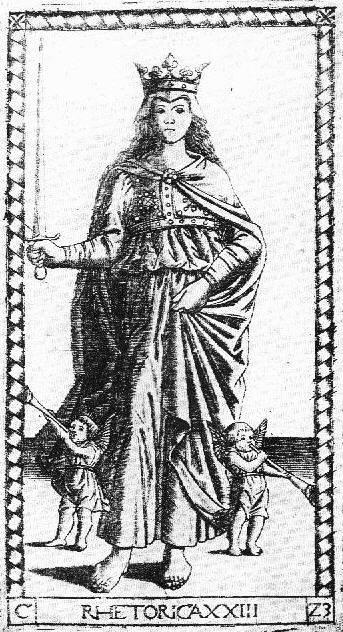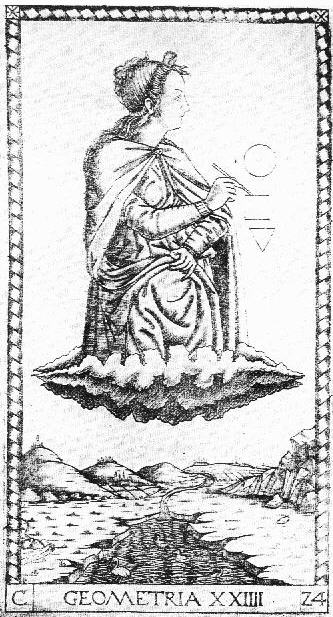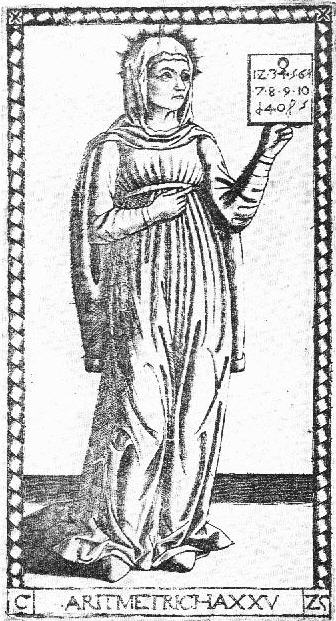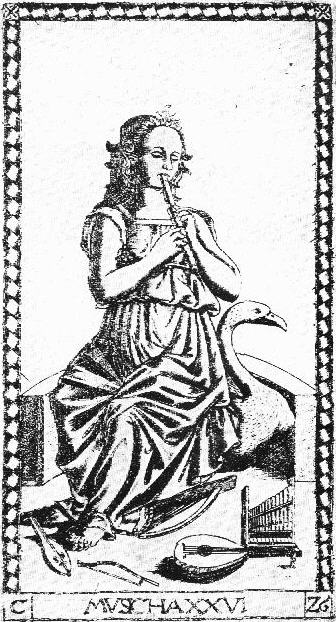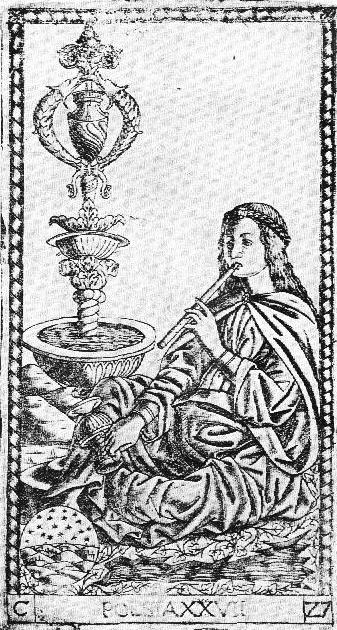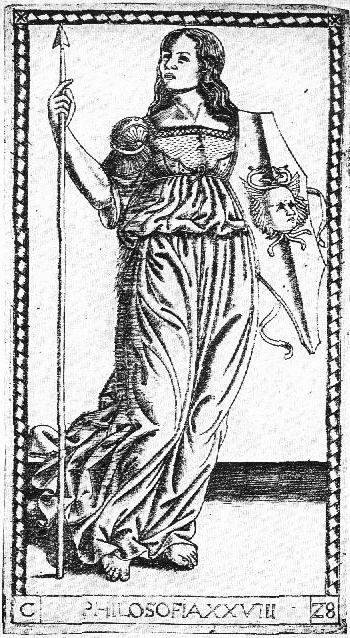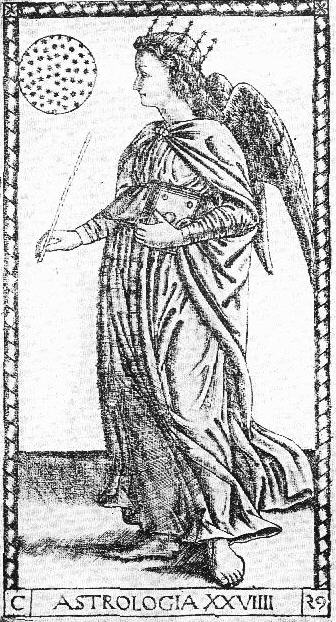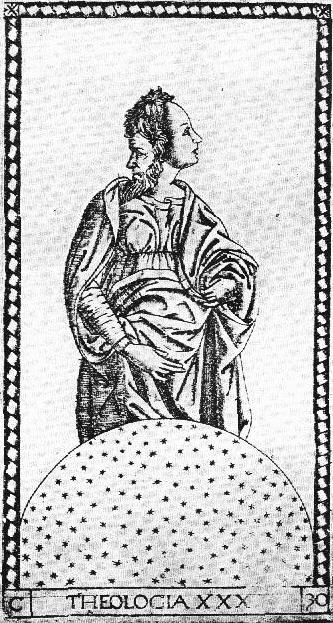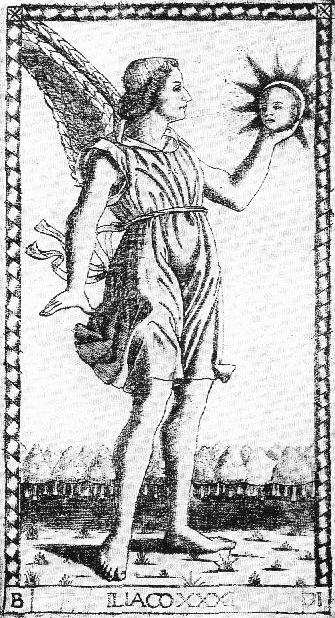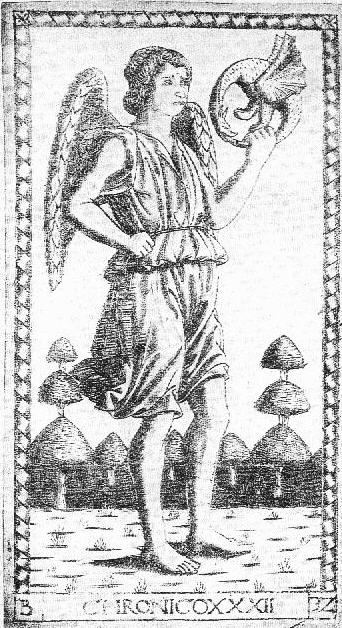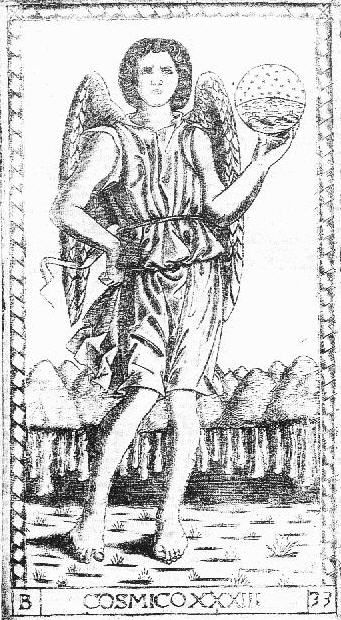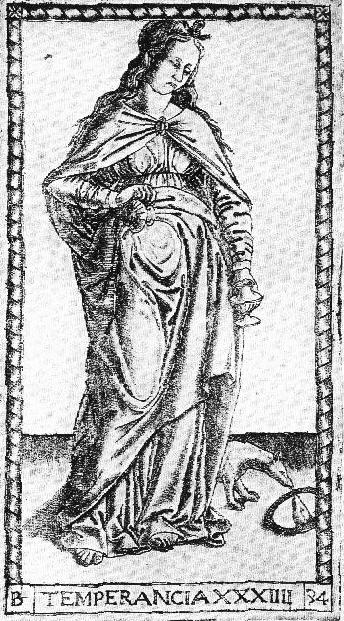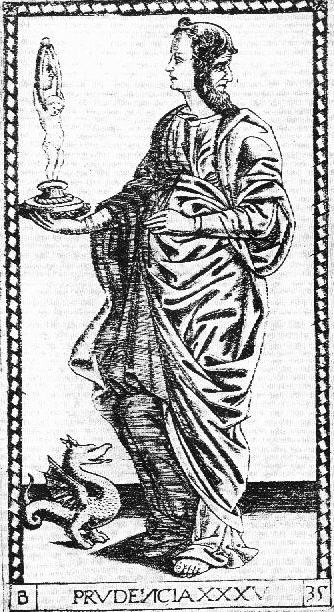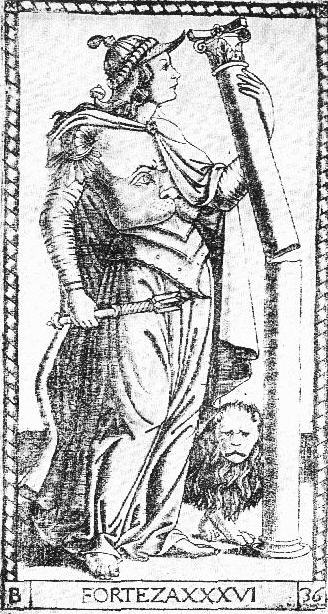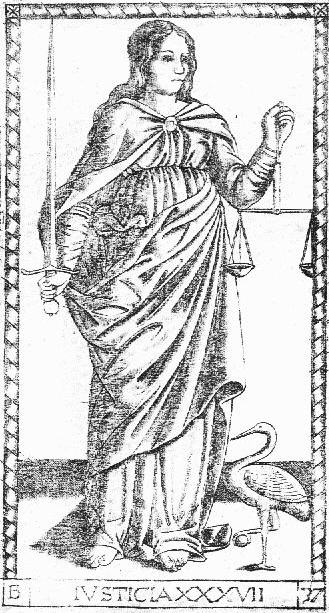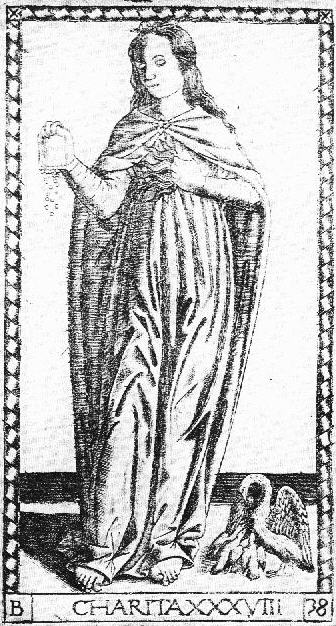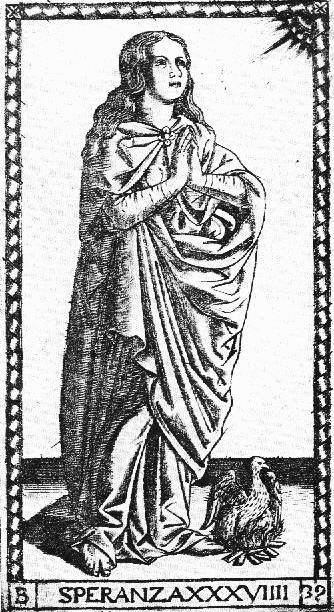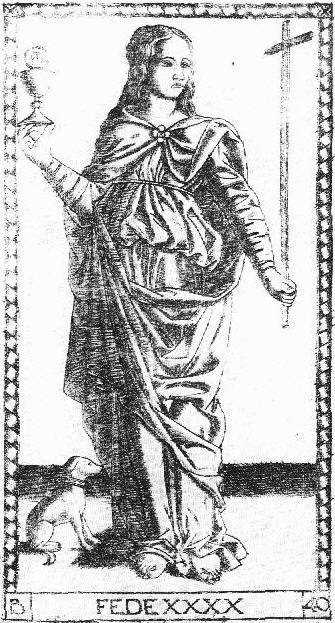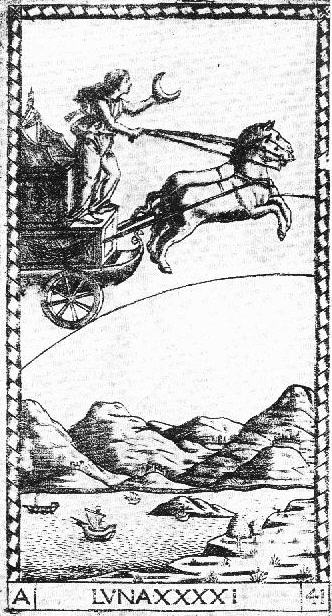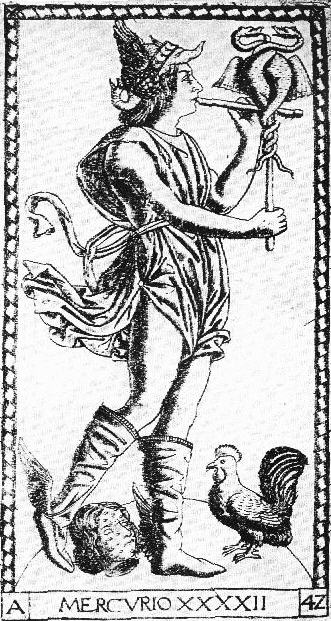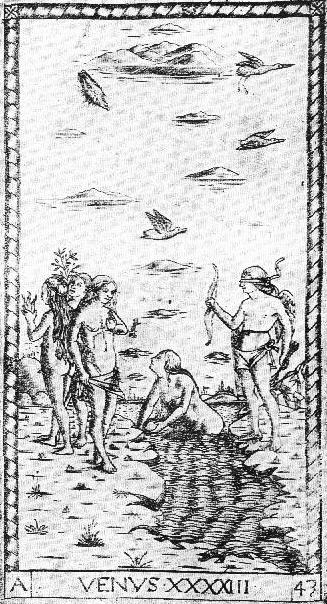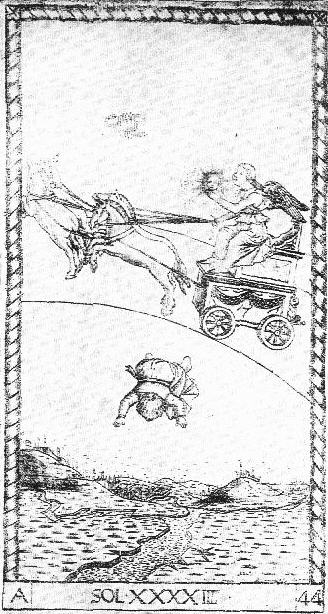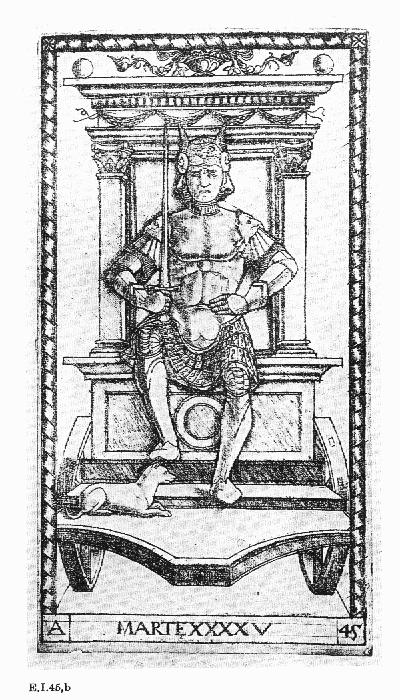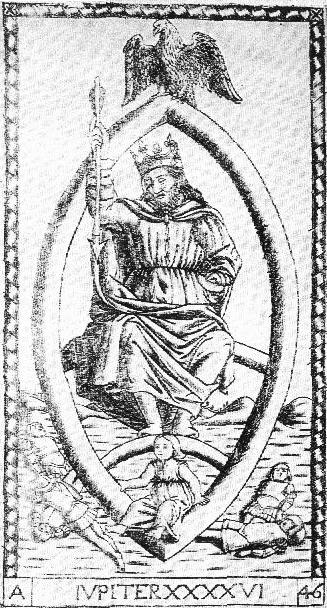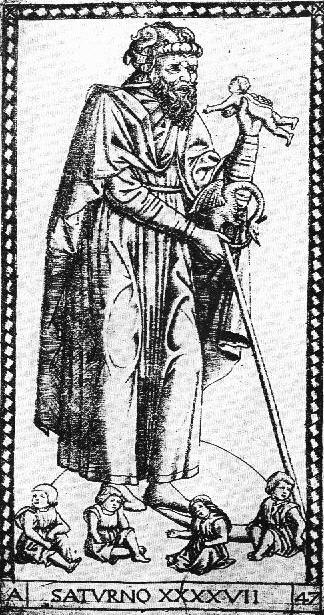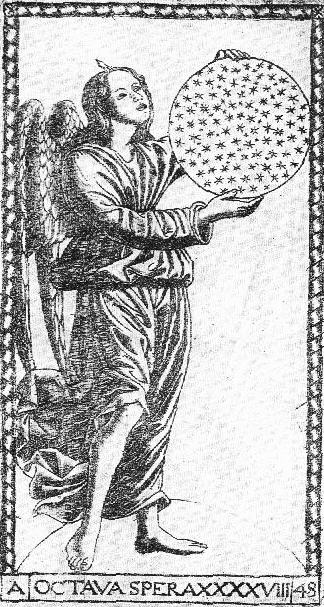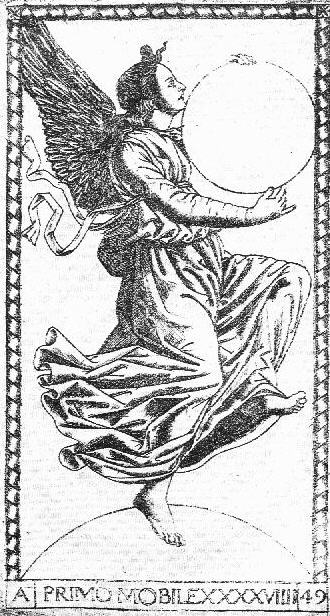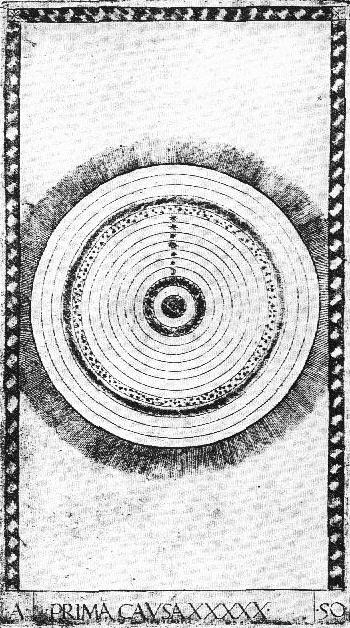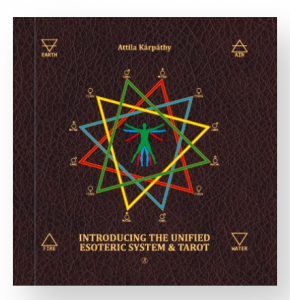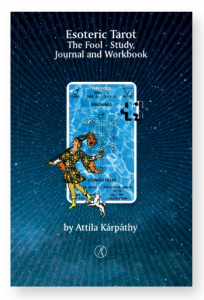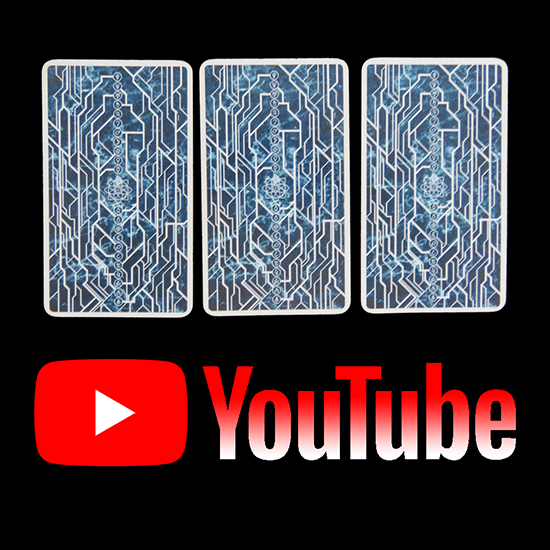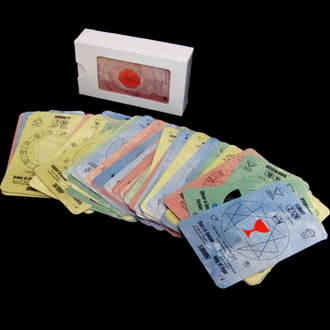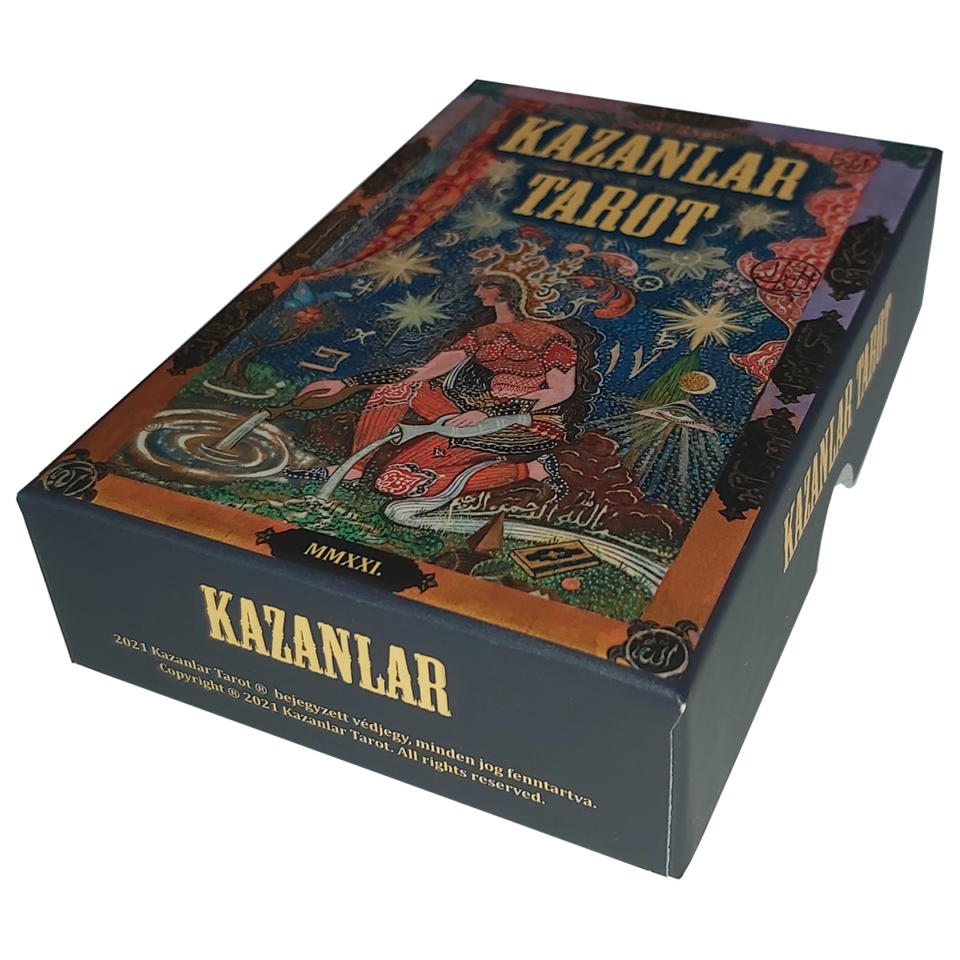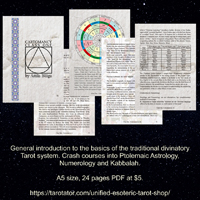The Mantegna Tarocchi, also known as the Tarocchi Cards, Tarocchi in the style of Mantegna, Baldini Cards, are two different sets each of fifty 15th-century Italian old master prints in engraving, by two different unknown artists. The sets are known as the E-series Tarocchi Cards and the S-series Tarocchi Cards (or E series, e-series etc.), and their artists are known as the “Master of the E-series Tarocchi” and the “Master of the S-series Tarocchi”. There are also a number of copies and later versions.
The name appears to be a mistaken confusion by later writers with the contemporary card-game of Tarocchi, which includes many extra picture-cards. These are neither playing cards nor Tarot cards for fortune-telling but were presumably educational tools for upper-class children, although no documentation of their use survives. Some sets bound up in book form at early dates survive, and all examples are printed on single sheets of thin paper.
They remain important examples of Italian engraving, and are mostly owned by museums as part of their collections of old master prints. The original two sets are called the E-series and the S-series, of which the E-series is generally considered the older (since AM Hind made the case). It is on the whole the better engraved, and usually the better printed of the two. Differences between the two show the E-series Master was more aware of the literary sources for his images. Most images are reversed between the series.
Their place and dates of creation are still debated, but Ferrara about 1465 (E-series) and 1470-5 (S-series) are considered most likely. Some of the images are copied in a manuscript dated 1467, which is believed to give a terminus ante quem for the E-series.
The titles of some cards are written in a Ferraran or Venetian dialect — “Doxe” for Doge or Duke, and “Artixan” for artisan. Some subjects were copied from playing-cards, and some from other sources in contemporary art. Other designs had to be invented. Two prints on quite different subjects have been generally attributed to the unknown “Master of the E-series Tarocchi”, and one to the “Master of the S-series Tarocchi”.
In card terms all are “picture” or “court” cards. There is the name and number of the card in Roman numerals at the bottom, and the group capital letter and number in arabic numerals in squares in the bottom corners. All have simple decorative borders. The subjects are grouped in five sequences numbered: 1-10, 11-20, 21-30, 31-40 and 41-50, each group consisting of ten engravings.
The complete set is a humanistic model of the Renaissance cosmos. The letter “E” of the first group, for “Estates” (of Man) in Italian was changed to the letter “S” for “Stations” between the E and S series, hence the names for the two series. (Source: Wikipedia)
E/S (1-10): Conditions of Man — Hierarchy of persons, from beggar to emperor and pope:
01 Beggar (Misero)
02 Servant (Fameio)
03 Craftsman (Artixan)
04 Merchant (Merchadante)
05 Gentleman (Zintilomo)
06 Knight (Chavalier)
07 Doge (Doxe)
08 King (Re)
09 Emperor (Imperator)
10 Pope (Papa)
D (11-20): The nine Muses and Apollo:
11 Calliope, the oldest muse (Caliope)
12 Urania (astronomy)
13 Terpsichore (Terpsicore)
14 Erato (love poetry and mimicry)
15 Polimnia, Polyhymnia (sacred poetry)
16 Talia, Thalia (comedy)
17 Melpomene (tragedy)
18 Euterpe (music)
19 Clio (history)
20 Apollo, accompanied by the Muses
C (21-30): The seven Liberal arts and three other basic sciences of the time: Philosophy, Astrology and Theology:
21 Grammar (Grammatica)
22 Logic (Loica)
23 Rhetoric (Rhetorica)
24 Geometry (Geometria)
25 Arithmetic (Aremetricha)
26 Music (Musicha)
27 Poetry (Poesia)
28 Philosophy (Philosophia)
29 Astrology (Astrologia)
30 Theology (Theologia)
B (31-40): 3 Genia of light: Genius of the Sun (Iliaco), Genius of Time (Chronico) and Genius of the world (Cosmico), and the Seven virtues:
31 Iliaco, genius of the sun
32 Chronico, genius of time
33 Cosmico, genius of the world
34 Temperancia, temperance
35 Prudencia or Prudentia, prudence, wisdom
36 Forteza or Fortitudo, strength, fortitude
37 Iusticia, Iustitia, justice
38 Charita, Caritas, caring love
39 Speranza or Spes, hope
40 Fede, Fides, faith
A (41-50): The seven Spheres of the Sun, Moon and five traditional planets (Mercury, Venus, Mars, Jupiter and Saturn), the eighth sphere (Octava Spera) of the fixed stars, the Primum Mobile and Prima Causa (First Cause, God):
41 Moon (Luna)
42 Mercury (Mercurio)
43 Venus
44 Sun (Sol)
45 Mars (Marte)
46 Jupiter (Iupiter)
47 Saturn (Saturno)
48 Eight Sphere (Octava Sphera)
49 First Movement (Primo Mobile)
50 First Cause (Prima Causa)
Albrecht Dürer drew copies of several during his visits to Italy 1495 and 1505, presumably just for his own reference.
More at: trionfi.com
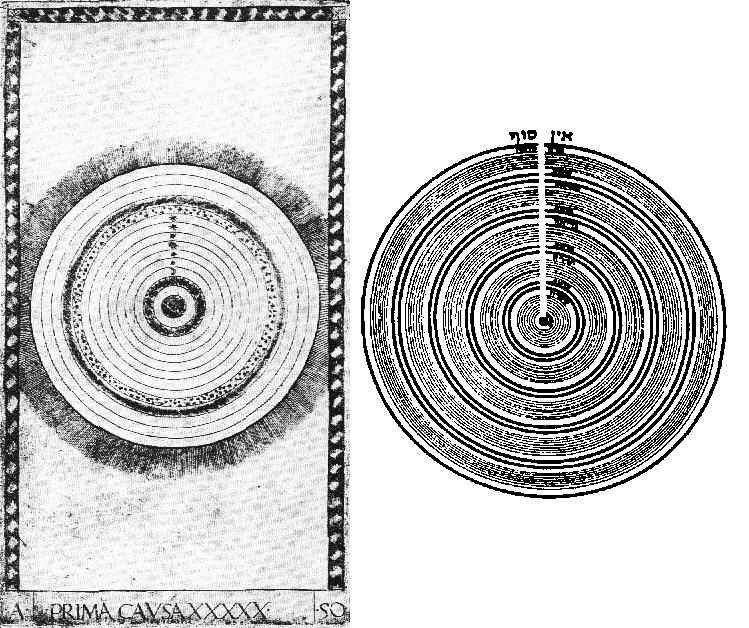
Although this is not a Tarot deck, I think very useful to study the symbolism of these cards and compare it to the Tarot cards. The card 50, Prima Causa (First cause) have an obvious kabbalistic symbol: the Ein Sof and one of the first representation of the Tree of Life. In this image, the Sephirot shown in the scheme of Iggulim (“Circles”).
This connection may tie this deck to the Kabbalah and further on the Tarot deck to the Kabbalah.
Ein Sof, or Ayn Sof (/eɪn sɒf/, Hebrew: אין סוף), in Kabbalah, is understood as God prior to his self-manifestation in the production of any spiritual realm, probably derived from Ibn Gabirol’s term, “the Endless One” (she-en lo tiklah).
Isaac Luria propounded the doctrine of the Tzimtzum, (meaning alternatively: “Contraction/Concealment/Condensation/Concentration”), the primordial Self-Withdrawal of Divinity to “make space” for subsequent Creation. This reconciles the Infiniteness of God with finite Creation, preventing created realms from being nullified into non-existence within their source of vitality.
The Lurianic Kabbalah is a school of kabbalah named after the Jewish rabbi who developed it: Isaac Luria (1534–1572; also known as the “ARI’zal”, “Ha’ARI” or”Ha’ARI Hakadosh”).
Previous Kabbalah taught that before the creation of the spiritual or physical realms, the Ein Sof (“Without End”) Divine simplicity filled all reality. In a mystical form of Divine self-revelation, the Ohr Ein Sof (“Light of the Ein Sof/Infinite Light”) shone within the Ein Sof, before any creation. In the absolute Unity of the Ein Sof, “no thing” (no limitation/end) could exist, as all would be nullified. About the Ein Sof, nothing can be postulated, as it transcends all grasp/definition. Medieval Kabbalah held that at the beginning of Creation, from the Ein Sof emerged from concealment the 10 Sephirot Divine attributes to emmanate existence. The vitality first shone to Adam Kadmon (“Primordial Man”), the realm of Divine Will), named metaphorically in relation to Man who is rooted in the initial Divine plan. From Adam Kadmon emerged sequentially the descending Four spiritual Realms: Atziluth (“Emanation” – the level of Divine Wisdom), Beriah (“Creation” – Divine Intellect), Yetzirah (“Formation” – Divine Emotions), Assiah (“Action” – Divine Realisation). In Medieval Kabbalah the problem of finite creation emerging from the Infinite was partially resolved by innumerable, successive tzimtzumim concealments/contractions/veilings of the Divine abundance down through the Worlds, successively reducing it to appropriate intensities. At each stage, the absorbed flow created realms, transmitting residue to lower levels.
To Luria, this causal chain did not resolve the difficulty, as the infinite quality of the Ohr Ein Sof, even if subject to countless veilings/contractions would still prevent independent existence. He advanced an initial, radical primordial Tzimtzum leap before Creation, the self-withdrawal of Divinity. At the centre of the Ein Sof, the withdrawal formed a metaphorical (non-spatial) Khalal/Makom Ponui (“Vacuum/Empty Space”) in which Creation would take place. The vacuum was not totally empty, as a slight Reshima (“Impression”) of the prior Reality remained, similar to water that clings to an emptied vessel.
Into the vacuum then shone a new light, the Kav (“Ray/Line”), a “thin” diminished extension from the original Infinite Light, which became the fountainhead for all subsequent Creation. While still infinite, this new vitality was radically different from the original Infinite Light, as it was now potentially tailored to the limited perspective of Creation. As the Ein Sof perfection encompassed both infinitude and finitude, so the Infinite Light possessed concealed-latent finite qualities. The Tzimtum allowed infinite qualities to retire into the Ein Sof, and potentially finite qualities to emerge. As the Kav shone into the centre of the vacuum it encompassed ten “concentric” Iggulim (the conceptual scheme of “Circles”), forming the sephirot, allowing the Light to appear in their diversity.
In the development of Luria’s school, debate considered the degree to which his scheme was metaphorical (more philosophical) or literal (more mythological). Differences over the tzimtum revolved over whether the Divine was immanent in Creation or not. However, all emphasised that concepts needed divestment from false corporeal-spatial interpretation. The dialectic between Tzimtum and Kav begins a dynamic of Divine exile/crisis-redemption/catharsis in Lurianism that continues to repeat through subsequent consequences in unfolding Creation. At each stage, the Divinity before the crisis returns in a new form afterwards, in order to allow rectification. Creative levels are no longer self-enclosed entities, complete in themselves. (Source: Wikipedia)

